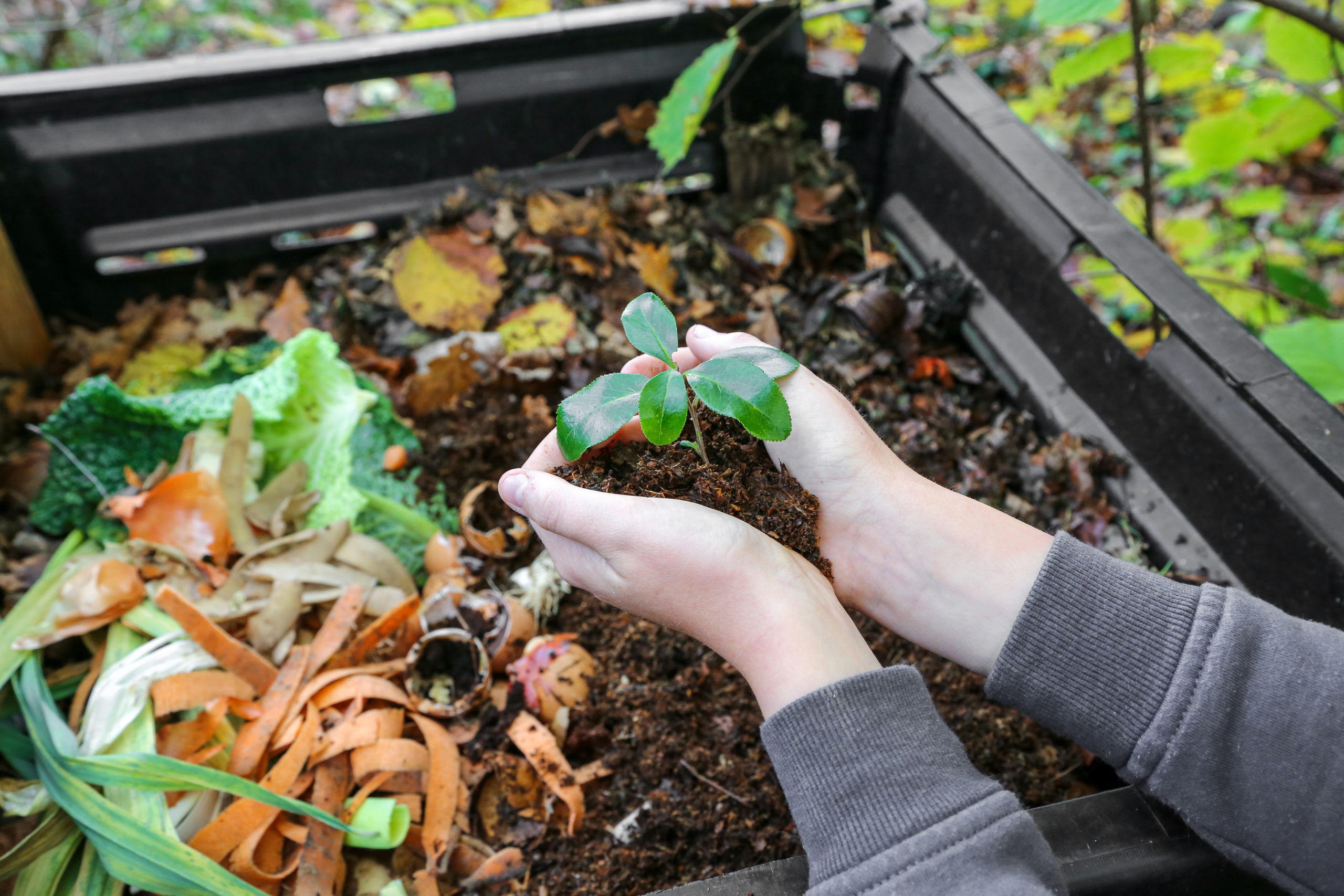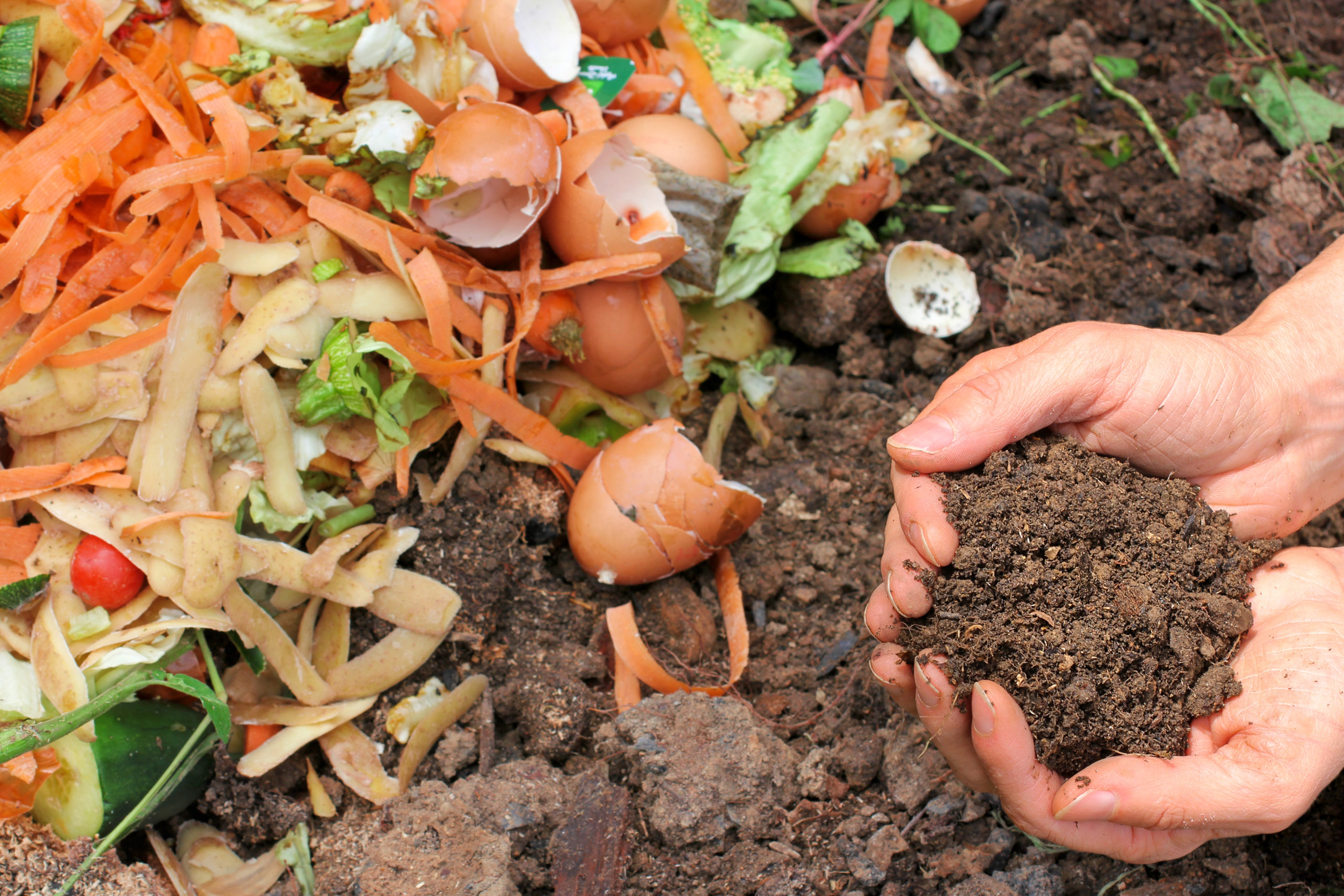Beginner’s Guide to Composting
March 25, 2022

Living in Southern California, you’ve likely heard of “compost” or “composting.” It produces a natural fertilizer that helps your plants grow and reduces methane gas emissions to fight climate change. But did you know it can also prevent stormwater pollution? Reducing stormwater pollution is critical to keeping Orange County’s creeks, rivers, and ocean healthy, so it’s up to all of us to do what we can to keep our water resources flourishing. Let’s dive in and explore what composting is, how to do it, and learn about all of the great ways it helps to protect our waterways!
What is Composting?
Composting recycles organic waste into a valuable fertilizer that can enrich soil and plants. It’s created by combining organic waste, such as food scraps and yard trimmings, into designated outdoor or indoor bins. All organic matter will break down eventually, and composting accelerates the decomposition process by providing a thriving environment for bacteria, fungi, and other organisms. Compost piles also heat up to high temperatures (between 130°F and 140°F), killing harmful germs and weed seeds that the decomposition process does not.
In Orange County, the storm drain and sanitary sewer systems are completely separate. Storm drains take water from rain events and outdoor water use directly to our waterways without being treated. On the other hand, water from indoor water use (from sinks, toilets, showers, etc.) travels through the sanitary sewer system where it is treated before being discharged to Orange County’s rivers, bays, and ocean. Composting can prevent harmful pollutants from getting into the storm drain system and our waterways. Here’s how:
Reduces Need for Chemical Fertilizers
Mature compost can serve as a natural alternative to chemical fertilizers. Chemical fertilizer can runoff, pollute waterways, and harm aquatic life if it enters the storm drain system. Compost, on the other hand, not only provides nutrients for your plants, it also helps keep nutrients in place so they don’t leach out and enter our waterways causing algal growth downstream.
Helps Soil Absorb More Water
Composting increases the soil’s ability to absorb and retain water resulting in less water consumption and runoff from your property. It also makes soil less likely to erode preventing loose dirt from flowing into our waterways.
Restores Soil Health
Mature compost can bind with and help break down pollutants like pesticides, heavy metals, and solvents. This prevents harmful substances from flowing untreated into our waterways.
Reduces Waste
Aside from reducing stormwater pollution, there are other benefits of composting that can even help reduce the impact of climate change. Food scraps and other organic waste generate methane, a greenhouse gas, during their decomposition at the landfills. Composting organic waste either at home or by placing material in the yard waste bin is a great way to reduce methane emissions and lower our carbon footprint! With the new mandated organics recycling law, SB 1383, it is now against the law in California to dispose of organic waste in your trash bin. If they haven’t already, your waste hauler will soon be providing a yard waste bin you can utilize!

How-To Compost at Home
Now you know what composting is and why it’s important, but how do you actually do it? There are several ways to compost at home, but here’s an easy and simple way for beginners:
If the spot you choose is too exposed to the sun, your compost pile can dry out easily. Contrarily, if it’s a wet spot, your pile will have an odor, attract pests, and won’t properly decompose. A shady and dry spot is the right balance for your pile.
1. Choose a shady and dry spot around three feet in diameter to place your compost pile. If you’re using a bin for your pile, get a ten gallon (20 gallon for a family of four) plastic bin with a secure lid.
It’s important to have the right balance of greens (nitrogen) and browns (carbon) for proper decomposition. Examples of greens are grass clippings, food scraps, and coffee grounds. Browns are dead leaves, branches, twigs, and shredded paper. Also, add two to four parts of brown materials for every one part of green materials. Keep going until you reach three feet.
2. To start your pile, add alternating thin layers of greens and browns, ending with a layer of browns.
Your pile should be as wet as a wrung-out sponge. If you include food waste in your pile, it’s likely to be wet enough, but if not, add water as appropriate. Be sure to not over wet the pile and cause runoff.
3. Ensure pile has proper moisture.
After the initial decomposition period, you can regularly turn your pile with a pitchfork or garden fork to give it enough moisture. Wait to add fruit and vegetables until your compost pile is established, then bury them under 10 inches of composted material to prevent pests and odors.
4. Leave the pile alone for four days to allow for initial decomposition to begin.
You should be turning your pile around once a week during summer and every three to four weeks during winter to give it enough oxygen.
5. Turn your pile more frequently during summer than winter.
A dark, rich color indicates your mature compost is ready to use and can take anywhere between two months to two years. Once ready, put the mature compost in your garden, enrich the soil in your yard, or donate it to a local farm.
6. Wait until the bottom of your pile is dark and rich in color.
For more information on how to compost, click here.
What To Compost
Now, let’s talk about what to compost at home. Only certain items can be composted at home, or your compost can get contaminated, attract pests, and harm surrounding plant life. Here’s a list of items that can be composted:
- Fruits and vegetables
- Eggshells
- Coffee grounds and filters
- Teabags
- Nutshells
- Shredded newspaper
- Cardboard
- Paper
- Yard trimmings
- Grass clippings
- Houseplants
- Hay and straw
- Leaves
- Sawdust
- Wood chips
- 100% Cotton or Wool Rags
- Hair and fur
- Fireplace ashes
What Not To Compost
To avoid running into issues, stay away from home composting of these items:
- Dairy products
- Fats, grease, lard, or oils
- Meat or fish bones and scraps
- Pet waste
- Diseased or insect-ridden plants
- Coal or charcoal ash
- Yard trimmings with chemical pesticides
Some items like meat and dairy can be composted in your curbside bin. Be sure to check with your waste hauler for more information.

Ways to Protect Our Waterways While Composting
- Contain your compost pile so that water and/or compost material does not runoff.
- Adjust your sprinklers accordingly – you may need less water when using compost.
- Plant ground cover so your fresh and valuable compost does not wash away.
Thank you for doing your part to reduce waste while protecting Orange County’s waterways!
Hello, thank you for the information. It is very helpful. What can be done with a neighbor that always washes his yard waste into the storm drains. The HOA has been procrastinating with placing the drain covers. When we mention not to do it he says oh it’s okay. Thank you for your time.
H2OC Stormwater Program Post author
Hello, we really appreciate you alerting us regarding the pollution occurring by your home. Please either visit https://myOCeServices.ocgov.com and submit a Service Request under Water Pollution, or call the 24-Hour pollution reporting hotline at 1-877-89-SPILL (77455). Thank you for protecting our waterways!